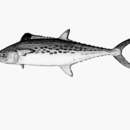Diagnostic Description
provided by Fishbase
Interpelvic process small and bifid. Body covered with small scales. Lateral line gradually curving down toward caudal peduncle. Intestine with 2 folds and 3 limbs. Swim bladder absent. Pelvic fins relatively long. Sides silvery with numerous round brownish (orange in life) spots, three rows above lateral line, one above. The first dorsal fin is black distally and white at the base. The second dorsal fin is tinged with yellowish and with black margin. The anal fin is white.
Migration
provided by Fishbase
Oceanodromous. Migrating within oceans typically between spawning and different feeding areas, as tunas do. Migrations should be cyclical and predictable and cover more than 100 km.
Morphology
provided by Fishbase
Dorsal spines (total): 15 - 18; Dorsal soft rays (total): 16 - 19; Analsoft rays: 16 - 21; Vertebrae: 46 - 49
Biology
provided by Fishbase
A schooling species believed to spawn close to the coast over most of its range. Adults occur near the surface of coastal waters to over bottom of the continental shelf (Ref. 11035). Adults feed on small fishes, particularly anchovies (Anchoa and Cetengraulis) and clupeids (Odontognathus and Opisthonema). The most abundant game fish along the Pacific coasts of Mexico and Central America. An excellent food fish enough to support a commercial fishery. Marketed fresh and frozen; also used for ceviche (Ref. 9987).
Importance
provided by Fishbase
fisheries: commercial; gamefish: yes
Pacific sierra: Brief Summary
provided by wikipedia EN
The Pacific sierra (Scomberomorus sierra) also known as the Mexican sierra, is a ray-finned bony fish in the family Scombridae, better known as the mackerel family. More specifically, this fish is a member of the tribe Scomberomorini, the Spanish mackerels. It occurs in the eastern Pacific Ocean from southern California to Antofagasta in Chile.
- license
- cc-by-sa-3.0
- copyright
- Wikipedia authors and editors

